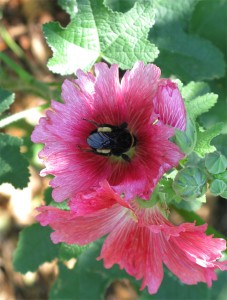 Yes, Virgini-ahh there are Hollyhocks and Roses that thrive in Florida! If you get Knock Out Roses and Vietnamese Hollyhocks, they will be carefree and will be able to take all the abuse Florida’s climate can dish out! Try to avoid hybrid roses and mail order Hollyhocks- which might not be suited for our climate.
Yes, Virgini-ahh there are Hollyhocks and Roses that thrive in Florida! If you get Knock Out Roses and Vietnamese Hollyhocks, they will be carefree and will be able to take all the abuse Florida’s climate can dish out! Try to avoid hybrid roses and mail order Hollyhocks- which might not be suited for our climate.
Long considered northern mainstays, Hollyhocks and Roses can bring color to your freeze-ravaged, early-spring Florida garden. While tropical plants recover from winter freezes and frosts between February and May, Hollyhocks and Roses will reward you with bodacious blooms. The Hollyhocks will cease blooming once the heat kicks in but the roses will continue to reward.
This post will be dedicated to Hollyhocks. More to come later on Knock Out Roses.
You can successfully grow Hollyhocks in Florida as long as you protect them from the afternoon sun and baby them until established. You need to deep water them for one and a half to two weeks every year for long term success. A friend Sue was delighted to find many of her Hollyhocks survived last summer and re-bloomed this spring. 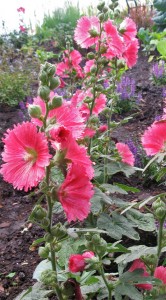 The first Hollyhock batch Sue bought two years ago were purchased from Bloom Nursery in Tampa. These stately spires were single pinks and labeled Vietnamese Hollyhocks.
The first Hollyhock batch Sue bought two years ago were purchased from Bloom Nursery in Tampa. These stately spires were single pinks and labeled Vietnamese Hollyhocks.
You might be wondering, “Hollyhocks in Vietnam”? Hollyhocks originate from China, so it isn’t a stretch that they would have made it to Vietnam. And growing Vietnamese Hollyhocks in Florida, really makes sense in that Vietnam and Florida have a lot of heat and humidity. The winning characteristic I have observed about Vietnamese Hollyhocks so far, is they don’t seem to have rust, which plagues Hollyhocks up north. If your Hollyhocks have been bothered a bit by spider mites and aphids, try using organic reemdies such as Neem Oil or Insectical Soap.
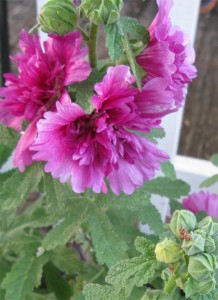
"Queeny Purple", a double hollyhock sports a luscious Grape Crush color
Garden Fairy Heather bought a group of Hollyhocks that ended up to be double frilly flowers on stately stalks, 2 to 3 feet tall. Wow– are they gorgeous. At first we thought they were all yellow, but they ended up to be mixed; pink, white, light yellow and the star of them all “Queeny Purple”, a luscious Grape Crush color.
Hollyhocks (Alcea rosea) bring back memories for many gardeners who remember their mother or grandmothers growing these short lived perennials. I remember making dolls out of hollyhock blossoms and seed pods. Hollyhocks are technically classified as biennials which means that takes two years to complete its life cycle. The first year the plant grows leaves, stems, and roots; producing flowers in its second year. A favorite of the English garden in the eighteen century, a typical garden would feature several varieties of Hollyhocks.
You can find Hollyhocks at specialty nursery centers and some of the farmers markets, but the large garden centers are yet to carry them.
Garden Fairy Factoids: Hollyhocks
1. Many websites state Hollyhocks flowers are edible. Many uses are listed; cook the buds, sautéed in a bit of butter with salt & pepper, add fresh petals to salads, leaves can be used in middle eastern/Egyptian cooking and brew a tea from the flowers. Colonial American gardeners grew hollyhocks for their cottage garden honey-making operations.
2. You can grow your own Hollyhocks from seeds.
3. Try using Hollyhocks in the back of the border, or as a blooming screen for unsightly views.
4. Use Hollyhocks in groups of at least three or in the middle of a large pot.
5. Deer don’t like to eat Hollyhocks.
6. Hollyhock House, designed by Frank Lloyd Wright for oil heiress Aline Barnsdall is located in Los Angeles. Hollyhocks are used in both abstracted and geometricized versions in much of the house’s design, including exterior walls and interior furniture. The house was built between 1919 and 1921.
If you have bug problems try organic remedies:
- Neem Oil- I mix up batches from concentrated oil that is available at most garden centers. Neem Oil disrupts insects’ hormonal balance so they die before they molt to the next life stage.
- Homemade Insecticidal Soap- Add 5 tbsp liquid dish detergent to 1 gallon water. Repeated sprayings will be required to kill the mites. While spraying, ensure that you do use it on the undersides of the leaves. This is because spray will only kill those spider mites that it comes in contact with.
- Alcohol and water- 1 part alcohol to 1 part water Since rubbing alcohol is poisonous, it will kill the mites on contact. At the same time, it evaporates quickly and thus, will do little damage to your plant. Make sure to use the spray on the entire plant, paying emphasis on the bottoms of the leaves.

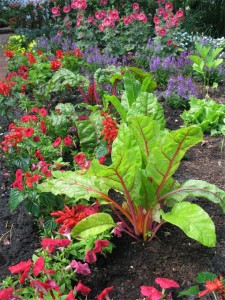
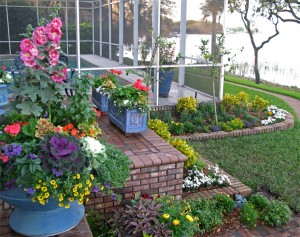
Interesting post. I’m a gardener myself, and I just stumbled upon your site.
Will be visiting more often from now on